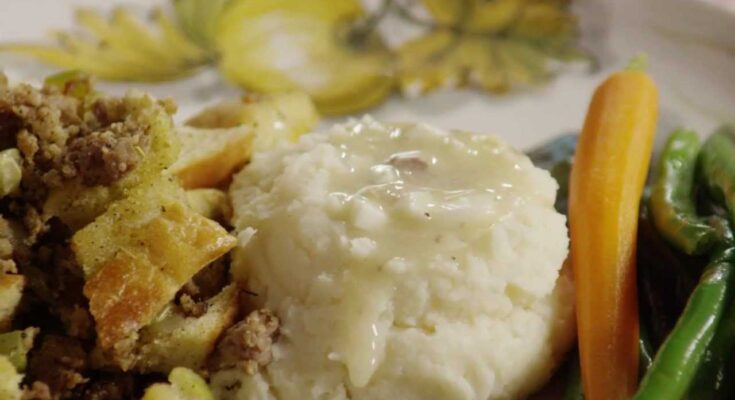Giblet Gravy Recipe: Giblet gravy is a traditional sauce made using the giblets (the heart, liver, gizzard, and sometimes the neck) of a turkey or chicken. Known for its rich and savory flavor, it is often served alongside turkey or mashed potatoes during holiday feasts, especially Thanksgiving and Christmas. The flavorful combination of meat drippings and giblets creates a unique depth of taste that stands out among holiday dishes.
Why Giblet Gravy Complements Your Holiday Feast
Giblet gravy is the perfect accompaniment for roasted turkey, mashed potatoes, and stuffing. Its robust flavor ties together the elements of a holiday meal, adding richness and warmth to every bite. The gravy not only enhances the taste of the main dish but also balances the overall texture of your plate by providing a silky, luscious component.
The Unique Flavor of Giblets
Giblets impart a distinct meaty taste to the gravy, which can be further customized with herbs, spices, and aromatics. The slow simmering process extracts the essence of the giblets, creating a stock that serves as the flavorful backbone of the dish.
Ingredients for Giblet Gravy
Essential Ingredients
To make giblet gravy, you’ll need:
- Giblets (heart, liver, gizzard, and neck)
- Turkey or chicken drippings
- All-purpose flour (for the roux)
- Unsalted butter
- Onion, celery, and garlic (for the stock)
- Water or chicken broth
- Salt and pepper to taste
Optional Ingredients for Enhanced Flavor
- Fresh herbs like thyme, parsley, and sage
- Heavy cream for a creamier texture
- Worcestershire sauce for umami flavor
- White wine for deglazing
Substitutions and Dietary Modifications
- Use gluten-free flour or cornstarch for a gluten-free version.
- Substitute butter with olive oil for a dairy-free option.
- For a vegetarian twist, use vegetable stock and omit the giblets.
Tools You’ll Need
Kitchen Essentials for Giblet Gravy
- A medium-sized saucepan
- A whisk for stirring the roux
- A sharp knife for chopping giblets
- A strainer or cheesecloth for stock
Pro Tips for Choosing the Right Tools
- Use a heavy-bottomed pan to avoid hot spots and ensure even cooking.
- A fine mesh strainer will help remove any solids for a smoother gravy texture.
Preparing the Giblets
Cleaning and Trimming the Giblets
Before starting, rinse the giblets thoroughly under cold water to remove any impurities. Trim off any excess fat or sinew from the gizzard. Pat them dry with a paper towel for easy handling.
Boiling the Giblets for Stock
Place the giblets and neck in a pot with water, onion, celery, garlic, and herbs. Bring to a boil, then reduce the heat and let it simmer for 1-2 hours. This slow process allows the flavors to develop and creates a rich stock.
Tips for Flavorful Giblet Stock
- Skim off any foam or impurities during the boiling process.
- For a more intense flavor, roast the giblets and neck before boiling.
- Add a splash of white wine to the stock for an extra layer of flavor.
Step-by-Step Guide to Making Giblet Gravy
Step 1: Make a Giblet Stock Base
Strain the stock once the giblets are tender and the flavors have melded together. Set the giblets aside to cool before chopping them into small, bite-sized pieces.
Step 2: Create a Roux
In a saucepan, melt butter over medium heat and whisk in flour. Cook the mixture for 2-3 minutes until it turns a golden brown. This step is crucial for the nutty flavor of the roux.
Step 3: Combine Roux with Stock
Gradually add the strained giblet stock to the roux, whisking constantly to prevent lumps. Let the mixture simmer until it thickens to your desired consistency.
Step 4: Add Cooked Giblets
Stir in the chopped giblets and simmer for another 5-10 minutes. Taste and adjust the seasoning with salt, pepper, and herbs as needed.
Step 5: Season and Finish the Gravy
Finish the gravy with a splash of cream or a pat of butter for a luxurious texture.
Variations and Serving Suggestions
Classic Giblet Gravy with Herbs
Add fresh thyme and parsley to the gravy for a classic herbaceous twist.
Creamy Giblet Gravy
Incorporate a cup of heavy cream to make the gravy richer and silkier.
Spiced Giblet Gravy for a Twist
Add a pinch of cayenne or smoked paprika for a spiced-up variation.
Storing and Reheating Giblet Gravy
Best Practices for Storing Giblet Gravy
Giblet gravy can be stored for later use, making it an excellent make-ahead option for busy holiday cooking schedules. Here’s how to do it:
- Refrigeration: Let the gravy cool completely before transferring it to an airtight container. Store it in the refrigerator for up to 3-4 days.
- Freezing: If you want to keep it longer, freeze the gravy in freezer-safe containers or resealable bags for up to 3 months. Lay the bags flat to save space.
Reheating Tips Without Losing Flavor
- Stovetop Method: Heat the gravy in a saucepan over low to medium heat, stirring frequently to avoid scorching. Add a splash of water or broth if the gravy has thickened too much during storage.
- Microwave Method: For smaller portions, use a microwave-safe container and reheat in 30-second increments, stirring between intervals.
- Pro Tip: Always taste the reheated gravy and adjust the seasoning if necessary, as flavors can change slightly during storage.
Troubleshooting Common Issues
Why is My Giblet Gravy Too Thin?
If your gravy isn’t thick enough, don’t panic! There are easy fixes:
- Mix 1 tablespoon of flour or cornstarch with 2 tablespoons of water to create a slurry. Whisk it into the gravy and let it simmer until thickened.
- Alternatively, simmer the gravy uncovered to reduce and concentrate its consistency.
How to Fix Lumps in Giblet Gravy
Lumpy gravy is a common issue, but it’s easily remedied:
- Strain the gravy through a fine mesh sieve or cheesecloth to remove lumps.
- To prevent lumps in the first place, add liquid to the roux gradually while whisking constantly.
Enhancing Bland Giblet Gravy
If your gravy lacks flavor, try these tips:
- Add a splash of Worcestershire sauce, soy sauce, or a pinch of bouillon powder for an umami boost.
- Stir in finely chopped fresh herbs like parsley, thyme, or sage for brightness.
Health Benefits of Giblets
Nutritional Value of Giblets
Giblets are nutrient-dense and provide a range of essential vitamins and minerals, including:
- Iron and Zinc: Support immune function and energy levels.
- B Vitamins: Crucial for brain health and energy metabolism.
- Protein: A lean source of protein to build and repair tissues.
Benefits of Incorporating Organ Meats into Your Diet
- Affordable Nutrition: Giblets are budget-friendly compared to other cuts of meat.
- Sustainability: Using every part of the bird reduces food waste and promotes sustainable eating.
FAQs about Giblet Gravy Recipe
What are giblets and how are they used in gravy?
Giblets refer to the edible offal of a fowl, typically including the heart, liver, and gizzard. In making giblet gravy, these parts are usually simmered to create a rich, flavorful stock that serves as the base. The meat is often finely chopped and added back into the gravy for texture and flavor.
Is giblet gravy safe to eat if I’m pregnant?
Giblet gravy is safe to consume during pregnancy as long as the giblets and gravy are cooked thoroughly to an internal temperature of 165°F to eliminate any harmful bacteria. Always consult with your healthcare provider about your diet during pregnancy.
Can I make giblet gravy ahead of time?
Yes, you can prepare giblet gravy in advance. Store it in the refrigerator for up to three days or freeze it for up to three months. Reheat on the stovetop or in the microwave until it is hot and simmering.
What can I substitute for giblets in the gravy?
If you prefer not to use giblets or don’t have them available, you can substitute them with chicken or turkey sausage, bacon, or additional poultry drippings for similar savory flavors.
How do I thicken giblet gravy?
To thicken giblet gravy, you can use a roux made from equal parts of fat (like butter) and flour, cooked until golden. Slowly whisk this mixture into your simmering stock to achieve the desired consistency. Alternatively, cornstarch dissolved in a little cold water can be used for a gluten-free option.
Conclusion
Giblet gravy is the unsung hero of holiday dinners, bringing warmth, richness, and flavor to your plate. With its versatile applications and budget-friendly ingredients, this traditional recipe is a must-have in your culinary arsenal. By following this step-by-step guide, you’ll be able to create a smooth, flavorful gravy that will elevate your feast to new heights.
Enjoy your homemade giblet gravy and impress your guests with its mouthwatering taste!



